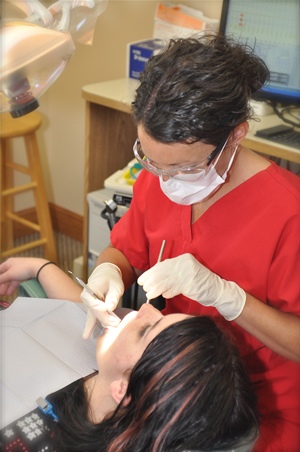Gum Disease Treatment
What is gum disease?
 Gum disease is a serious infection of the gum and bone surrounding the teeth. As the disease progresses the bone that holds teeth in place is eroded away. Eventually this can lead to tooth loss, if the gum disease is not treated. Studies are showing a strong relationship to dental infections and other infections in the body. We are learning that we must have good oral health in order to have good overall health. Gum disease is treated in a variety of ways depending on the stage, how you have responded to earlier treatments, and your overall health.
Gum disease is a serious infection of the gum and bone surrounding the teeth. As the disease progresses the bone that holds teeth in place is eroded away. Eventually this can lead to tooth loss, if the gum disease is not treated. Studies are showing a strong relationship to dental infections and other infections in the body. We are learning that we must have good oral health in order to have good overall health. Gum disease is treated in a variety of ways depending on the stage, how you have responded to earlier treatments, and your overall health.
Treatments range from nonsurgical therapies that control bacterial growth to surgery to restore supportive tissues.
Non-surgical treatments for gum disease
Professional dental cleaning. During a typical checkup your dentist or dental hygienist will remove the plaque and tartar (tartar is plaque that builds up and hardens on the tooth surface and can only be removed with professional cleaning) above and below the gum line of all your teeth. If you have signs of gum disease, we may recommend professional dental cleanings more than twice-a-year.
Scaling and root planing. This is a deep-cleaning, nonsurgical procedure, done under a local anesthetic, whereby plaque and tartar from above and below the gum line are scraped away (scaling) and rough spots on the tooth root are made smooth (planing). Smoothing the rough spots removes bacteria and provides a clean surface for the gums to reattach to the teeth. Scaling and root planing is done if your dentist or periodontist determines that you have plaque and calculus (hardened plaque, also called tartar) under the gums that needs to be removed. This treatment is often performed over two to four appointments.
Localized Antibiotics. Certain patients may benefit from placement of a localized antibiotic in the deeper pockets around teeth in conjunction with root planing. These combination therapies are intended to reduce gum inflammation, bleeding, and pocket depth.
 We recommend Arestin™ which starts working quickly, right at the source of the infection, and keeps fighting bacteria long after you leave the dental office. It applied directly to the infected areas right after the scaling and root planing procedure. Click here to watch an informative video.
We recommend Arestin™ which starts working quickly, right at the source of the infection, and keeps fighting bacteria long after you leave the dental office. It applied directly to the infected areas right after the scaling and root planing procedure. Click here to watch an informative video.
Periodontal Maintenance Visits. It is important to maintain frequent periodontal maintenance appointments (follow-up appointments, usually every 3 to 4 months) with your dentist and hygienist after root planing has been completed. Gum disease can not be cured, the progression can only be halted in certain cases.
Surgical treatments for gum disease
In more advanced stages of gum disease additional surgical treatment may be indicated in order to stop the progression of gum disease, the ultimate goal is to save natural teeth. Sometimes this can be accomplished and other times, in more advanced stages teeth can not be saved. Your dentist may work with you and a specialist called a Periodontist to determine the best treatment for you.